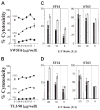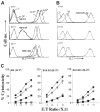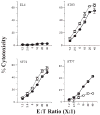NKG2D receptor-mediated NK cell function is regulated by inhibitory Ly49 receptors
- PMID: 15328154
- PMCID: PMC3889208
- DOI: 10.1182/blood-2004-03-1075
NKG2D receptor-mediated NK cell function is regulated by inhibitory Ly49 receptors
Abstract
Interaction of the activating ligand H60 with NKG2D receptor constitutes a major stimulatory pathway for natural killer (NK) cells. The influence of inhibitory Ly49 receptors on NKG2D-mediated activation is not clearly understood. Here we show that the magnitude of NKG2D-mediated cytotoxicity is directly proportional to both the levels of H60 and the nature of major histocompatibility complex (MHC) class I molecules expressed on the target cells. The expression levels of H60 on the target cells determined the extent to which the inhibition by Ly49C/I receptors can be overridden. In contrast, even a higher expression of H60 molecule on the target cells failed to overcome the inhibition mediated by Ly49A/G receptors. Also, the level of interferon-gamma (IFN-gamma) and granulocyte-macrophage colony-stimulating factor (GM-CSF) generated by NK cells through anti-NKG2D monoclonal antibody (mAb)-mediated activation is significantly reduced by the presence of immobilized anti-Ly49A/G mAbs. Thus, NKG2D-mediated cytotoxicity and cytokine secretion results from the fine balance between activating and inhibitory receptors, thereby defining the NK cell-mediated immune responses.
Figures






 , anti-Ly49A and anti-Ly49G2 combined with indicated mAb concentrations.
, anti-Ly49A and anti-Ly49G2 combined with indicated mAb concentrations.
Similar articles
-
A role for the src family kinase Fyn in NK cell activation and the formation of the repertoire of Ly49 receptors.Eur J Immunol. 2002 Mar;32(3):773-82. doi: 10.1002/1521-4141(200203)32:3<773::AID-IMMU773>3.0.CO;2-U. Eur J Immunol. 2002. PMID: 11870621
-
Crystal structure of the Ly49I natural killer cell receptor reveals variability in dimerization mode within the Ly49 family.J Mol Biol. 2002 Jul 12;320(3):573-85. doi: 10.1016/s0022-2836(02)00498-9. J Mol Biol. 2002. PMID: 12096910
-
The balancing act: inhibitory Ly49 regulate NKG2D-mediated NK cell functions.Semin Immunol. 2006 Jun;18(3):186-92. doi: 10.1016/j.smim.2006.04.002. Semin Immunol. 2006. PMID: 16737823 Free PMC article. Review.
-
Activating and inhibitory Ly49 receptors modulate NK cell chemotaxis to CXC chemokine ligand (CXCL) 10 and CXCL12.J Immunol. 2003 Sep 15;171(6):2889-95. doi: 10.4049/jimmunol.171.6.2889. J Immunol. 2003. PMID: 12960311
-
Structural basis of MHC class I recognition by natural killer cell receptors.Immunol Rev. 2001 Jun;181:52-65. doi: 10.1034/j.1600-065x.2001.1810104.x. Immunol Rev. 2001. PMID: 11513152 Review.
Cited by
-
Signaling by Fyn-ADAP via the Carma1-Bcl-10-MAP3K7 signalosome exclusively regulates inflammatory cytokine production in NK cells.Nat Immunol. 2013 Nov;14(11):1127-36. doi: 10.1038/ni.2708. Epub 2013 Sep 15. Nat Immunol. 2013. PMID: 24036998 Free PMC article.
-
IL-27 promotes NK cell effector functions via Maf-Nrf2 pathway during influenza infection.Sci Rep. 2019 Mar 21;9(1):4984. doi: 10.1038/s41598-019-41478-6. Sci Rep. 2019. PMID: 30899058 Free PMC article.
-
Deficiencies in Natural Killer Cell Numbers, Expansion, and Function at the Pre-Neoplastic Stage of Pancreatic Cancer by KRAS Mutation in the Pancreas of Obese Mice.Front Immunol. 2018 Jun 21;9:1229. doi: 10.3389/fimmu.2018.01229. eCollection 2018. Front Immunol. 2018. PMID: 29977235 Free PMC article.
-
Sarcoma IL-12 overexpression facilitates NK cell immunomodulation.Sci Rep. 2021 Apr 15;11(1):8321. doi: 10.1038/s41598-021-87700-2. Sci Rep. 2021. PMID: 33859303 Free PMC article.
-
Nanoscale Colocalization of NK Cell Activating and Inhibitory Receptors Controls Signal Integration.Front Immunol. 2022 Jun 1;13:868496. doi: 10.3389/fimmu.2022.868496. eCollection 2022. Front Immunol. 2022. PMID: 35720315 Free PMC article.
References
-
- Vyas YM, Maniar H, Dupont B. Visualization of signaling pathways and cortical cytoskeleton in cytolytic and noncytolytic natural killer cell immune synapses. Immunol Rev. 2002;189:161–178. - PubMed
-
- Karre K, Ljunggren HG, Piontek G, Kiessling R. Selective rejection of H-2-deficient lymphoma variants suggests alternative immune defence strategy. Nature. 1986;319:675–678. - PubMed
-
- Yu YY, George T, Dorfman JR, et al. The role of Ly49A and 5E6(Ly49C) molecules in hybrid resistance mediated by murine natural killer cells against normal T cell blasts. Immunity. 1996;4:67–76. - PubMed
-
- Hanke T, Takizawa H, McMahon CW, et al. Direct assessment of MHC class I binding by seven Ly49 inhibitory NK cell receptors. Immunity. 1999;11:67–77. - PubMed
Publication types
MeSH terms
Substances
Grants and funding
LinkOut - more resources
Full Text Sources
Other Literature Sources
Molecular Biology Databases
Research Materials

